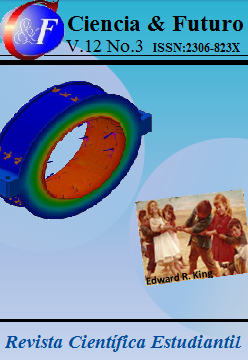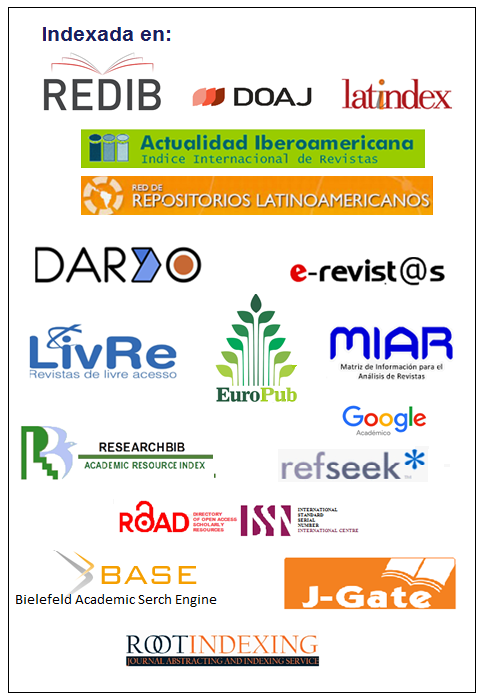Use of the phenomenon of rotary friction in a lathe machine for the union of dissimile alloys
Keywords:
rotary friction, dissimilar, forging, hardnessAbstract
The metallurgical union between the Cu-DHP copper alloy and the AISI 1045 steel was obtained from the phenomenon of rotary friction with the use of a lathe machine tool. The union was made with a number of revolutions of 1 400 r/min in bars of 12 mm in diameter and 100 mm in length, welding pressure of 30 MPa was applied. Process variables were welding time, pressure, and forging time. In the thermomechanically affected zone and the affected thermal zone, it was possible to determine that there is the α and β phase and cuprous oxide (Cu2O) on the Cu-DHP side and in the AISI 1045 steel, the presence of the residual austenitic phase, the martensite and α phase, product of the atomic interaction between both alloys. The hardness increased from 89.7 HV in copper and 180 HV in AISI 1045 to 389 HV in ZTMA.Downloads
References
BUFFA, G.; FRATINI, L.; PASTA, S. & SHIVPURI, R. 2008. On the thermo-mechanical loads and the resultant residual stresses in friction stir processing operations. CIRP Annals-Manufacturing Technology 57(1): 287-290.
GUZMÁN-ROMERO, E.; FERNÁNDEZ-COLUMBIÉ, T.; ALCÁNTARA-BORGES, D. & RODRÍGUEZ-GONZÁLEZ, I. 2017. Efecto de la velocidad angular y la presión en el proceso de soldadura por fricción radial en una aleación de aluminio AA 5754. Minería y Geología 33(3): 312-325.
KIMURA, M.; FUJI, A. & SHIBATA, S. 2015. Joint properties of friction welded joint between pure magnesium and pure aluminium with post-weld heat treatment. Materials and Design 85(10): 169-179.
KOTESWARA, P.; MOHAN, V.; SURYA, N. & KRISHNA, G. 2017. Effect of speed on hardness in rotary friction welding process. International Journal of Materials Science 12(4): 635-641.
LIANG, Z.; QIN, G.; WANG, L.; MENG, X. & LI, F. 2015. Microstructural characterization and mechanical properties of dissimilar friction welding of 1060 aluminum to AZ31B magnesium alloy. Materials Science and Engineering A 645(214): 170-180.
MAALEKIAN, M. & CERJAK, H. 2015. Modelling the orbital friction welding of pearlitic steel bars, Trends in Welding Research, Proceedings of the 8th conference, 736-741.
MERCAN, S.; AYDIN, S. & OZDEMIR, N. 2015. Effect of welding parameters on the fatigue properties of dissimilar AISI 2205–AISI 1020 joined by friction welding. International Journal of Fatigue. 81(12): 78-90.
MUMIN, S. 2016. Optimizing the parameters for friction welding stainless steel to copper Parts. Materials and technology 50(1): 109-115.
SESHAGIRIRAO, B.; SIVARAMAKRISHNA, V. & SAIKRISHNAPRASAD, G. 2015. Experimental investigation of rotary friction welding parameters of aluminum (H-30) and mild steel (AISI-1040). International Journal of Innovative Research in Science, Engineering and Technology 4(5): 2920-2925.
SHANJEEVI, C.; JESWIN. J.; ARPUTHABALAN, R.; DUTTA, D. & PRADEEP, S. 2017. Investigation on the effect of friction welding parameters on impact strength in dissimilar joints. Materials Science and Engineering 197(100): 3-7.
SRIRAM, R. & RAMADOSS. R. 2015. A study on mechanical and metallurgical properties of friction welded dissimilar materials. International Journal for Research in Applied Science & Engineering Technology (IJRASET) 3(1): 32-38.
SUPPACHAI, C.; CHAIYOOT, M. & MUHAMAD, T. 2017. Rotary friction welding of dissimilar joints between SSM 356 and SSM 6061 aluminum alloys produced by GISS. Engineering Journal 21(1): 181-191.
WEGLOWSKI, A. 2011. Friction stir processing-analysis of the process. Archives of metallurgy and materials 56(12): 779-788.
Published
How to Cite
Issue
Section
Esta obra está bajo una Licencia Creative Commons Reconocimiento-NoComercial 4.0 Internacional
La Revista Ciencia & Futuro es una revista de acceso abierto, todo el contenido está disponible gratuitamente sin cargo para el usuario o su institución. Los usuarios pueden leer, descargar, copiar, distribuir, imprimir, buscar o vincular los textos completos de los artículos, o utilizarlos para cualquier otro fin lícito, sin pedir permiso previo al editor o al autor. Todo lo anterior, de acuerdo con la definición de BOAI de acceso abierto.
Los autores que publican en esta revista están de acuerdo con los siguientes términos: Licencia Creative Commons Atribución-NoComercial permite que el beneficiario de la licencia tenga el derecho de copiar, distribuir, exhibir y representar la obra y hacer obras derivadas para fines no comerciales siempre y cuando reconozca y cite la obra de la forma especificada por el autor o el licenciante. Los autores pueden establecer por separado acuerdos adicionales para la distribución no exclusiva de la versión de la obra publicada en la revista (por ejemplo, situarlo en un repositorio institucional o publicarlo en un libro), con un reconocimiento de su publicación inicial en esta revista. Se permite y se anima a los autores a difundir sus trabajos electrónicamente (por ejemplo, en repositorios institucionales o en su propio sitio web) antes y durante el proceso de envío, ya que puede dar lugar a intercambios productivos, así como a una citación más temprana y mayor de los trabajos publicados (Véase The Effect of Open Access) (en inglés). Lo anterior debe realizarse siempre sobre el artículo ya publicado por Ciencia & Futuro.
Los autores mantienen el control sobre la integridad de sus trabajos y el derecho a ser adecuadamente reconocidos y citados.
A los editores se les otorgan derechos no exclusivos para publicar y distribuir.




